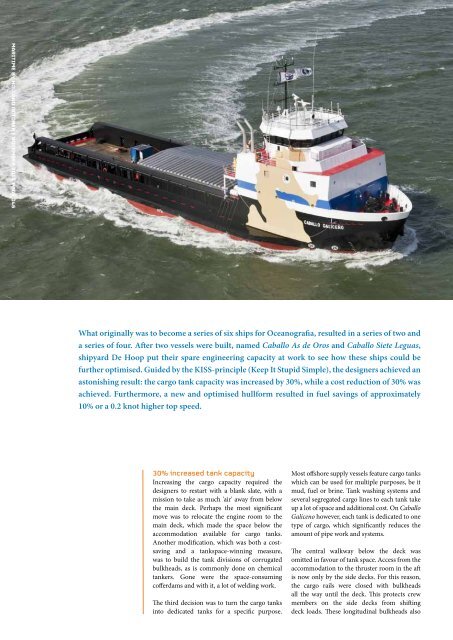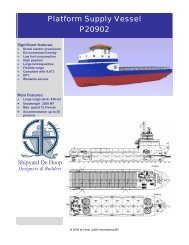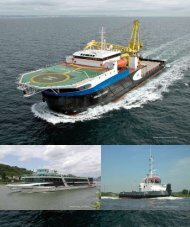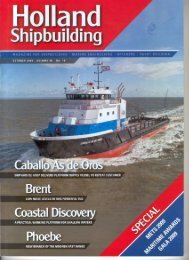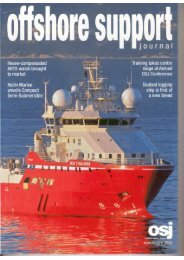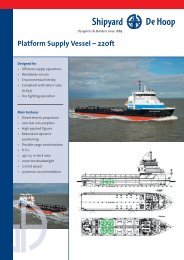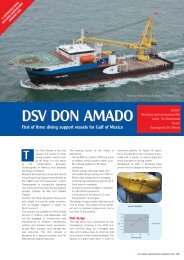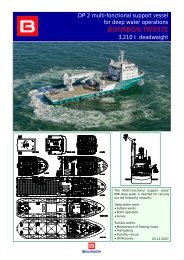2011 November Maritime by Holland Kiss Suppliers - De Hoop
2011 November Maritime by Holland Kiss Suppliers - De Hoop
2011 November Maritime by Holland Kiss Suppliers - De Hoop
Create successful ePaper yourself
Turn your PDF publications into a flip-book with our unique Google optimized e-Paper software.
MARITIME BY HOLLAND OCTOBER / NOVEMBER <strong>2011</strong> PAGE 046<br />
What originally was to become a series of six ships for Oceanografia, resulted in a series of two and<br />
a series of four. After two vessels were built, named Caballo As de Oros and Caballo Siete Leguas,<br />
shipyard <strong>De</strong> <strong>Hoop</strong> put their spare engineering capacity at work to see how these ships could be<br />
further optimised. Guided <strong>by</strong> the KISS-principle (Keep It Stupid Simple), the designers achieved an<br />
astonishing result: the cargo tank capacity was increased <strong>by</strong> 30%, while a cost reduction of 30% was<br />
achieved. Furthermore, a new and optimised hullform resulted in fuel savings of approximately<br />
10% or a 0.2 knot higher top speed.<br />
30% increased tank capacity<br />
Increasing the cargo capacity required the<br />
designers to restart with a blank slate, with a<br />
mission to take as much 'air' away from below<br />
the main deck. Perhaps the most significant<br />
move was to relocate the engine room to the<br />
main deck, which made the space below the<br />
accommodation available for cargo tanks.<br />
Another modification, which was both a costsaving<br />
and a tankspace-winning measure,<br />
was to build the tank divisions of corrugated<br />
bulkheads, as is commonly done on chemical<br />
tankers. Gone were the space-consuming<br />
cofferdams and with it, a lot of welding work.<br />
The third decision was to turn the cargo tanks<br />
into dedicated tanks for a specific purpose.<br />
Most offshore supply vessels feature cargo tanks<br />
which can be used for multiple purposes, be it<br />
mud, fuel or brine. Tank washing systems and<br />
several segregated cargo lines to each tank take<br />
up a lot of space and additional cost. On Caballo<br />
Galiceno however, each tank is dedicated to one<br />
type of cargo, which significantly reduces the<br />
amount of pipe work and systems.<br />
The central walkway below the deck was<br />
omitted in favour of tank space. Access from the<br />
accommodation to the thruster room in the aft<br />
is now only <strong>by</strong> the side decks. For this reason,<br />
the cargo rails were closed with bulkheads<br />
all the way until the deck. This protects crew<br />
members on the side decks from shifting<br />
deck loads. These longitudinal bulkheads also
CABALLO GALICENO<br />
KISS SUPPLIER WITH 30% MORE TANK CAPACITY AT 30% LESS COST<br />
© Reprinted from <strong>Maritime</strong> <strong>by</strong> <strong>Holland</strong>, No. 7, September/October <strong>2011</strong>, www.maritimeholland.com. Publisher: Navingo BV, www.navingo.com<br />
Builder<br />
Shipyard <strong>De</strong> <strong>Hoop</strong>, Foxhol, the Netherlands<br />
Owner<br />
Oceanografía, Ciudad del Carmen, Mexico<br />
Principal particulars<br />
Length o.a.<br />
Length b.p.p.<br />
Beam mld.<br />
<strong>De</strong>pth mld.<br />
<strong>De</strong>sign draught<br />
Scantling draught<br />
<strong>De</strong>adweight<br />
Gross tonnage<br />
Net tonnage<br />
67.00 m<br />
61.93 m<br />
12.80 m<br />
5.50 m<br />
4.55 m<br />
4.65 m<br />
2450 ton<br />
2085 ton<br />
1150 ton<br />
MARITIME BY HOLLAND OCTOBER / NOVEMBER <strong>2011</strong> PAGE 047<br />
Crew complement<br />
30 persons<br />
Capacities<br />
Free deck space 422 m 2<br />
Fuel 600 m 3<br />
Fresh water 150 m 3<br />
Drilling water 797 m 3<br />
Liquid mud 647 m 3<br />
Brine 330 m 3<br />
Dry bulk 225 m 3<br />
Propulsion<br />
Main engines 3 x 950 ekW Caterpillar C32<br />
Main thrusters 2 x 900 kW Veth Z-drives<br />
Bow thrusters 2 x 450 kW Veth tunnel thrusters<br />
Max speed<br />
12 knots<br />
A part of the aft working deck is covered to protect the mud-processing plant from the elements<br />
provide an excellent supporting surface for the<br />
cargo lines and power cables for the thrusters.<br />
30% reduced cost<br />
The building cost was reduced through the<br />
combination of many improvements. A new<br />
hullform was developed which consists entirely<br />
of developable plating, thus eliminating the cost<br />
of double-bended plate.<br />
The optimised hullform, fruit of a collaboration<br />
with MARIN, has a wavemaking resistance of<br />
30% less than the hull of Caballo As de Oros.<br />
Due to the steepness of the resistance curve, this<br />
translates to an increase in top speed of only 0.2<br />
knots. But, when sailing at the same cruising<br />
speed as Caballo As <strong>De</strong> Oros, Caballo Galiceno<br />
burns about 10% less fuel. A late modification<br />
however has eliminated this advantage, of<br />
which later more.<br />
The accommodation was also reviewed. Costs<br />
were saved <strong>by</strong> building an accommodation with<br />
one tier less. By increasing the width and the<br />
length of the accommodation, the same floor<br />
area was maintained, but less space was used for<br />
hallways and stairs.<br />
Diesel-electric propulsion<br />
In the design of Caballo Galiceno, full advantage<br />
has been taken of the fact that diesel-electric<br />
propulsion allows to locate the propulsion<br />
engines freely. The location of the engine rooms<br />
above the main deck has significantly reduced<br />
the space normally 'lost' for exhaust lines and<br />
engine room ventilation ducts.<br />
Three diesel generator sets, based on Caterpillar<br />
C32-ACERT engines, are located in two engine<br />
rooms on either side of a central changing room<br />
on the main deck. Each rated at 950 ekW, they<br />
can work in parallel to provide sufficient power<br />
for two azimuthing thrusters from Veth in the<br />
aft and two tunnel thrusters in the bow. A power<br />
management system prevents overloading of<br />
the engines <strong>by</strong> matching the number of gensets<br />
running to the required load. Over 95% loading,<br />
the propulsion power will be reduced <strong>by</strong> the<br />
Dynamic Positioning system. Over 100%, nonessential<br />
consumers will be cut off from power,<br />
such as cargo pumps or the galley.
The location of the engine room on the main<br />
deck has another practical advantage. Should<br />
a generator need replacement or a thorough<br />
overhaul, a transport opening can easily be made<br />
in the aft bulkhead and the generator driven out<br />
to the working deck with a forklift truck. When<br />
the series of six vessels for Oceanografia will<br />
be completed, they will have 18 identical diesel<br />
generators in service, which makes it practical<br />
to carry out overhauls on a spare unit onshore<br />
and substitute a diesel generator for the spare<br />
one each time, thus reducing the downtime<br />
of the entire ship to a minimum. Carefull<br />
consideration has been given to noise-insulation,<br />
with the generators now on maindeck level.<br />
This has resulted in very acceptable noise levels<br />
complying with IMO regulations and equivalent<br />
with Comfort Class 3.<br />
Cargo tanks<br />
While there is no longer a central walkway<br />
between the tanks towards the aft, the void<br />
space on centreline in the double bottom<br />
has been maintained. This proved extremely<br />
practical, as the tank suctions for the cargo<br />
lines are joined from below to the bottom of the<br />
tanks, resulting in much better emptying than<br />
with regular tank suctions from the top. It also<br />
helps that the tank bottoms slope downwards<br />
towards the centreline, leaving very little residue<br />
after complete emptying. To keep the mud in<br />
suspension, the four mud-tanks are fitted with<br />
a mud mixing installation. Both the mud tanks<br />
and the brine tanks are also equipped with a<br />
jetwater system on the bottom, which can be<br />
used to inject either water or air into the tanks,<br />
making the mixture lighter. Transferring of the<br />
cargo is with two mud pumps and a brine pump<br />
which are located in the aft cargo room, where<br />
two of the four cylindrically shaped bulk tanks<br />
are located. These bulk tanks are used for either<br />
cement or barite.<br />
DP always in command<br />
Another cost reduction was possible in the<br />
wheelhouse. Instead of having two navigation<br />
desks, one facing forward and one facing<br />
aft, the pilot seat is now located on a sliding<br />
track between two consoles, which can be<br />
used when navigating in both directions. This<br />
is an arrangement comparable with those<br />
often seen on harbour tugs. In the control<br />
system, a simplification was made <strong>by</strong> running<br />
all operational modes through the dynamic<br />
positioning system (from Navis). Even when<br />
the captain uses the manual controls or joystick<br />
control, his commands are actually translated<br />
to generator and thruster orders through<br />
the DP system. The result is that the power<br />
management system of the DP system is always<br />
The same bridge consoles are used for navigation (facing forward) and maneuvering on DP (facing aft)<br />
The engine room is located above the main deck, creating more space for cargo tanks below<br />
in charge, omitting the need for a separate power<br />
management system in the main switchboard.<br />
A further simplification was made <strong>by</strong><br />
concentrating all variable frequency drives<br />
(VFDs) in one large air-conditioned<br />
switchboard room, just forward of the engine<br />
room on the main deck. As a result, the thruster<br />
room in the aft and the bowthruster room did<br />
not require air-conditioning anymore and could<br />
do with mechanical ventilation. Some extra<br />
filters were needed on the electrical system to<br />
prevent harmonic distortions.<br />
Contract in the Gulf<br />
During the final stages of construction of the<br />
first ship in the new series, named Don Alfonso,<br />
shipowner Oceanografia secured a five-year<br />
contract for all four vessels in the Gulf of<br />
Mexico. Instead of regular supply service, the<br />
vessels will be employed as so-called mudvessels.<br />
They will remain permanently stationed<br />
at a drilling platform to deliver drilling mud,<br />
which is used to lubricate the drilling bit and<br />
create sufficient hydrostatic pressure in the well<br />
to prevent the escape of oil or gas. This drilling<br />
mud is a mixture, of which the ingredients,<br />
such as mud and brine (heavily salted water)<br />
are balanced based on the need. For this<br />
purpose, a mud processing plant is installed<br />
on the aft working deck. This part of the aft<br />
deck is covered with removable hatch covers to<br />
protect the equipment from the elements. The<br />
piping connection with the drilling platform<br />
is permanently intact, allowing an immediate<br />
response with an appropriate mix of drilling<br />
mud when needed. The only problem with the<br />
five-year contract was that for this application,<br />
where a particularly heavy type of mud is<br />
needed, the deadweight of the ships needed to<br />
be increased.<br />
MARITIME BY HOLLAND OCTOBER / NOVEMBER <strong>2011</strong> PAGE 049
MARITIME BY HOLLAND OCTOBER / NOVEMBER <strong>2011</strong> PAGE 051<br />
After launching in Foxhol, each of the four vessels receives sponsoons in the drydock in Harlingen<br />
Sponsoons<br />
Various options were considered, such as<br />
lengthening the ships, but the most economical<br />
solution was to add two-metre wide sponsoons<br />
to either side of the vessel. Because of the limited<br />
beam in <strong>De</strong> <strong>Hoop</strong>'s Foxhol shipyard, this work<br />
was carried out at Shipdock Harlingen. The<br />
sponsoons are connected to the side tanks which<br />
are used for water ballast or drilling water. The<br />
modification increased the deadweight from<br />
2050 ton to 2450 ton. Another modification,<br />
specifically needed for this contract, was the<br />
upgrade of the dynamic positioning system<br />
from DP class I to DP class II. This required all<br />
power supplies to be routed along two different<br />
paths, along with the addition of an extra DP<br />
computer and an extra visual position reference<br />
system (CYSAM).<br />
Shipyard <strong>De</strong> <strong>Hoop</strong> managed to do everything in<br />
a very short time. While the order for the extra<br />
modifications was given in April, Don Alfonso<br />
was already on its way to Mexico in July. While<br />
the sponsoons look anything but elegant, initial<br />
worries about a significant loss in top speed<br />
proved unwarranted. The speed reduction was<br />
only 0.2 knots, exactly the same amount as was<br />
gained <strong>by</strong> optimising the hull form. The same<br />
modification was done to Caballo Galiceno<br />
and will be done to the two remaining KISS<br />
suppliers in the series.<br />
Low cost per ton deadweight<br />
Technical director Fré Drenth points out that<br />
this new series of KISS suppliers are built at a<br />
lower cost per ton deadweight than comparable<br />
Chinese-built suppliers, but with a shorter<br />
delivery time, more room for customisation <strong>by</strong><br />
the owner and less need for owner supervision<br />
during construction. Indeed, Oceanografia,<br />
which has a long history with <strong>De</strong> <strong>Hoop</strong>, did<br />
not have a build team in the yard during<br />
construction. The relation with the Mexican oil<br />
industry actually already started in the 1970s,<br />
when <strong>De</strong> <strong>Hoop</strong> built tankers and tugs for Pemex,<br />
short for Petróleos Mexicanos. Oceanografia<br />
have worked for Pemex for the last forty years.<br />
Current work on hands at Shipyard <strong>De</strong><br />
<strong>Hoop</strong> includes two more KISS suppliers for<br />
Oceanografia, four river cruise vessels and<br />
accommodation units for a cable layer.<br />
Bruno Bouckaert
Subcontractors and suppliers of equipment<br />
fitted on board the Caballo Galiceno - YN 435<br />
Alphatron Marine, Rotterdam<br />
: radio equipment; dynamic positioning<br />
Bazo Staalbeer, Westervoort<br />
: ventilation grills<br />
Blommaert Scheepsluiken, Wijnegem, Belgium : sliding roof<br />
Boer Staal, <strong>De</strong>, Uitgeest<br />
: steel<br />
Bovi, Tubbergen<br />
: curtains<br />
Carlsen Offshore System, Krimpen a/d IJssel : bulk handling system<br />
Chemetall, Oss<br />
: Ampak magnesium anodes<br />
Datema, <strong>De</strong>lfzijl<br />
: fire-fighting and live saving equipment<br />
<strong>De</strong>no Compressors, Krimpen a/d IJssel : compressors<br />
Droste Elektro, Lobith-Tolkamer<br />
: propulsion drives, bowthrusters, mudpump systems, transformers<br />
propulsion<br />
Econosto Nederland, Capelle a/d IJssel : valves<br />
Eekels Elektrotechniek, Hoogezand : complete electrical installation<br />
Facet Industrial, Almere<br />
: bilgewater separator<br />
FFS, Norway<br />
: Fi-Fi pumps and monitors<br />
GEA Westfalia Separator Nederland, Cuijk : fuel separator<br />
Haan Gebr. <strong>De</strong>, Hoogezand<br />
: airconditioning; ventilation; freshwater installation<br />
Imtech Marine & Offshore, Rotterdam : GTK galley equipment<br />
Kraaijeveld Machine en Lierenfabriek, C,<br />
Papendrecht<br />
: anchor winches<br />
MacGregor, Kaarine, Finland<br />
: lashing equipment<br />
Nautische Unie Hunfeld, Farmsum : liferafts<br />
Ned-<strong>De</strong>ck Marine, Barneveld<br />
: rescue-boat; Hydraulic slewing rescue boat davit<br />
Noordhof Schilderwerken, Kropswolde : painting<br />
NRF, Mill<br />
: boxcoolers<br />
Pars-Navis, Westerbroek<br />
Pon Power, Papendrecht<br />
Qua-Vac, Almere<br />
Reikon, Spijkenisse<br />
REMAT, Breda<br />
Roelofs en Zn, Nijverdal<br />
Rubber <strong>De</strong>sign, Heerjansdam<br />
Seafix, Rotterdam<br />
SEC, Ship’s Equipment Centre, Groningen<br />
Shipdock, Harlingen<br />
SIN, Oranjewoud<br />
Smits Neuchâtel, Utrecht<br />
Technisch Buro Koehein, Scherpenzeel<br />
Temaro, Rotterdam<br />
Theunissen Technical Trading, Malden<br />
Toekomst, <strong>De</strong>, Waspik<br />
Top, Boskoop<br />
Trinoxx, Hardinxveld-Giessendam<br />
VAF Instruments, Dordrecht<br />
VDI Isolatie, Ridderkerk<br />
Veld Koeltechniek, Groenloo<br />
Veth Propulsion, Papendrecht<br />
Vries, R.J. de, <strong>De</strong>lfzijl<br />
Jac de Vries Gesta, Middenbeemster<br />
Westerman, Winschoten<br />
Wetcab, Poland<br />
Winel, Assen<br />
Wingerden & Zn, H.K. van, Vuren<br />
Wortelboer, Rotterdam<br />
: prefab accommodation<br />
: Caterpillar engine; harbour diesel generator<br />
: Evac sewage plant; Electrolux washing- and drying machine<br />
: Azcue pumps<br />
: main propulsion; bow thrusters; mud pumps<br />
: stainless steel stairs and handrails<br />
: flexible mounts<br />
: fire extinguishing system<br />
: bollards and cocks<br />
: construction hull sponsoons<br />
: piping<br />
: underfloors<br />
: stair steps<br />
: SolvaSolv sunscreens<br />
: Eltek addressable fire detection system<br />
: gangway<br />
: SOPEP; cargo securing manual CSM<br />
: walls, doors and ceilings<br />
: flowmeters<br />
: insulation<br />
: provision cooling<br />
: Veth z-drives; Veth tunnel thrusters<br />
: mooring ropes<br />
: hotwater boiler<br />
: aluminium main mast, compass platform and radar masts<br />
: wet cells<br />
: tank vent check valves and watertight musketeer doors<br />
: portholes and Wigo windows<br />
: anchor and chains<br />
MARITIME BY HOLLAND OCTOBER / NOVEMBER <strong>2011</strong> PAGE 053


